#korean language tips
Text
anon asked: i am a beginner and I want to learn Korean. I know that you have your masterlist about what to do next and its really good to look for self study resources but i’m only 18 and i do not have money for a course to learn. what is your advice because i know you say to take a class when you can thank you so much
Coming out of this hiatus to say:
Take FREE classes on Coursera. This is not sponsored, not an ad, not a gimmick. If you’re really at a beginner level and you need that Academic Input of any language, please, please PLEASE take free courses where you can. If you want to take TTMIK too, please do that as well! It’s free to sign up and you don’t need the books.
Taking free Korean classes on Coursera has some awesome benefits from a linguistics standpoint. First off, you get a structured curriculum created by language experts who know their stuff. They break down the language step by step, so you can really understand how it works. Plus, the interactive lessons and exercises on Coursera keep things interesting and help you practice listening, speaking, reading, and writing. And here's the cool part: you can learn from experienced instructors and chat with other learners from around the world. So, if you want to dive into Korean (in a class like setting), give Coursera a shot.
You might have to self-regulate your studying -- as in, complete the course at your own pace. But if you’re diligent and motivated, then please check that out.
TTMIK
Coursera Korean Courses (browse a little (because not all of them are about learning Korean) and choose the free option)
Hope that helps! Happy Learning :)
~ sk101
#korean#Korean Langauge#korean language tips#korean language blog#Korean langblr#klangblr#langblr#study korean#learn korean
168 notes
·
View notes
Text
Look, I knew five languages by age 19 and now I am learning like 3 more. I work as a language instructor and a consultant. If I can give language learners only one advice, this is it.
STOP LEARNING WORDS ON THEIR OWN.
You're doing yourself a disservice by learning lists of "30 words you must know!" "100 most common words!" like it literally means nothing if you cannot use those words in an appropriate context with proper grammar. So what you actually need to do is learn those words via example sentences.
Of course, sentences have more words so you may think you're learning less but you're actually learning the way to use it in context. That's what's important.
Language is about communication, which also means if you want to learn languages, you have to observe how people communicate with each other universally. Native speakers never have a list of words they know and they don't count every single new word they've learned. So why are you doing it to yourself? What native speakers do is listen to the new word, remember the context they're spoken in, and keep using that word in that context. And that's why people go "wait, you can use that word LIKE THAT?" all the time. So you, a language learner, are also allowed to do that. I'm not even saying those word lists are useless but they're the most useful AFTER you've known most of them and are trying to go over them for practice etc. Native speakers do click on those word lists to check out how many words they don't know or to remind themselves of those words or to learn some facts about each word. That should be your goal as well.
Learn sentences. Learn them in context. Do not fall into the "I must know xx amount of words or I'm a failure at language learning" trap perpetuated by bloggers or youtubers or whatever. Have fun with it!
#language learning#studyblr#langblr#100 days of productivity#chinese studyblr#japanese studyblr#korean studyblr#how to learn#learning#academia#academic#academics#language study#language#languages#study tip#study#study motivation
181 notes
·
View notes
Text
Checklist for starting a language
- (if needed) learn the alphabet
- basic grammar for forming words and pronunciation
This process alone would take a few hours maybe 2-3 depending on the difficulty and the difficulty depends on your native language
- 1000 most common words in your native language (translate to target language)
Translate favorite medias into target language
This could be songs, movie quotes, scenes, or anything from your own writing.
Attempt to pronounce these by looking at the writing.
I’ve been making flash cards for alphabet and sounds
I’m new to language learning so if anything I said is less effective than another strategy please let me know.
#language learning#polyglot#study tips#korean language#learn korean#learn japanese#langblr#korean langblr
398 notes
·
View notes
Text
Hello! *shyly waving*
I've had this blog for a lil while and want to start posting original content asap but for now I'll try to make an intro post fisrt.
My blog is running on queue untill I gather some material to post. See you soon!
#studyblr#langblr#studyspo#study inspo#japanese#nihongo#korean#chinese#mandarin#study motivation#study notes#study space#language learning#language#languages#college#academia#student#bookworm#bujoinspo#study blog#study inspiration#study tips#studying#studyblr community#studyinspo#student life#study aesthetic
27 notes
·
View notes
Text
How to say "I love you" in your partner's language - Part 1
English: I love you
Spanish: Te quiero / Te amo
French: Je t'aime
Italian: Ti amo
German: Ich liebe dich
Portuguese: Eu te amo
Russian: Я тебя люблю (Ya tebya lyublyu)
Chinese (Mandarin): 我爱你 (Wǒ ài nǐ)
Japanese: 愛してる (Ai shiteru)
Korean: 사랑해 (Saranghae)
Arabic: أحبك (Ana bahebak)
Hindi: मैं तुमसे प्यार करता/करती हूँ (Main tumse pyaar karta/karti hoon)
Greek: Σ'αγαπώ (S'agapo)
Turkish: Seni seviyorum
Dutch: Ik hou van jou
Swedish: Jag älskar dig
Bokmål: Jeg elsker deg
Finnish: Rakastan sinua
Polish: Kocham cię
Hungarian: Szeretlek
Nynorsk: Eg elskar deg
Dangme (spoken in Ghana): I suɔ mo.
We'll add more languages in the nest posts. Ask if you want to add your own language or different phrases. We're always open to feedback!
#i love you#education#relationships#cultural differences#relationship goals#tumblr stuff#relationship advice#dating tips#how to date#hungarian#polish#finnish#norwegian#swedish#turkish#greek#hindi#arabic#korean#japanese#chinese#russian#portuguese#german#french#italian#spanish#english#languages#language stuff
24 notes
·
View notes
Note
hiii! <3 💕💞
im sure you have been asked this question a lot, so i apologize if its bothersome 🥹, but isnt it hard to study both chinese and japanese at the same time? ive been thinking about picking up on some chinese myself, but i always worry that ill end up confusing some readings of the chinese symbols with the japanese onyomi readings for kanji.
so i guess my question is, how do you manage? 🥺
and good luck for your february goals <333 💞💖🫶🏻
hi hana! どうもありがと, thank you so much 💖 大丈夫, no need to apologize, you're never a bother 🥺 to answer your question... yes, i am always confused 😂
BUT here's where it comes in handy that i'm also learning Korean! Because Korean 🤝 Japanese on phonetics and sentence structure but Chinese 🤝 Japanese on Kanji characters and their semantics!
so i've ended up in a situation where my listening skills for Japanese are better than my reading skills and if there's a Kanji character, then i probably know the meaning, but maybe not the pronunciation in Japanese because what i know from Chinese is overriding it 🤡 i plan to do a lot more Kanji review + Japanese comprehensible input to address this gap 👌
i'm barely at N5 in Japanese though (that's my goal for this year hehe) and i'm coming from the opposite perspective (Chinese > Japanese) than you (Japanese > Chinese), but i hope this is still helpful for you to at least get some ideas for how to tackle your own journey! 頑張ります! 💕
💌 if anyone else with experience learning Japanese + Chinese sees this and has anything to add please do! 🙏
#studyblr#japanese langblr#chinese langblr#korean langblr#asks#친구#study advice#learning languages#langblr#language learning#language study#language stuff#multilingual#polyglot#study tips
18 notes
·
View notes
Text

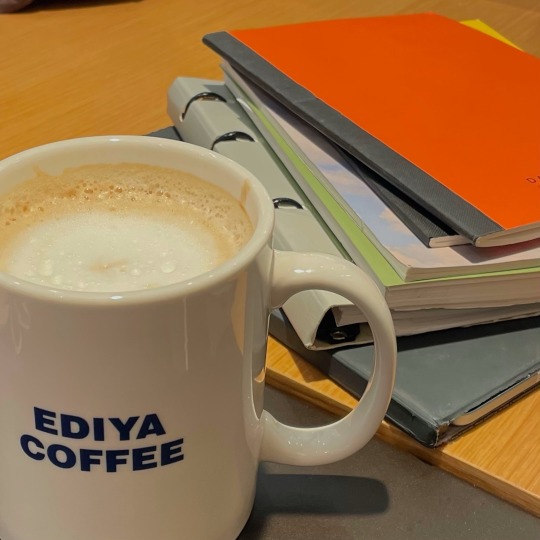
am i a coffee addict? absolutely.
finishing summaries of 2 Korean articles is a goal for today. it’s a homework for our political translation course. writing summaries is time-consuming as you need to comprehend the text in Korean, which is difficult. such kind of articles are full of new words we’re supposed to learn by heart.
so, there’s pattern that works for me:
1. finding new words and their definition
2. translation of the paragraphs, one by one
3. highlighting the main ideas in each paragraph and quotes that can’t be omitted
4. putting all the highlighted parts together, using necessary grammar
boom, you’re cool because you have done the assignment and practiced translating🤝🏻
#exchange student#korea#student life#studying#language#university#university life#studyblr#translation#linguistics#university aesthetic#university studyspo#university student#study blog#foreign languages#tips for students#coffee#korean cafe#cafe aesthetic#cafe#study motivation#student#university struggles#university studyblr#studyspo#study aesthetic#light acadamia aesthetic#light academia#korean language
28 notes
·
View notes
Photo
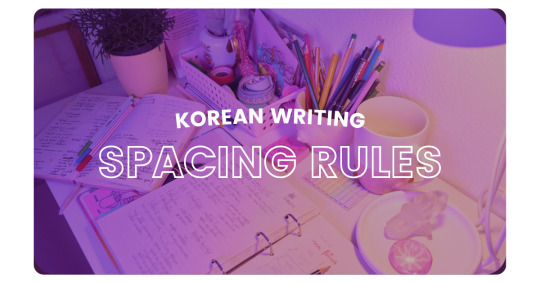
Writing in Korean can be quite complex when it comes to spacing (띄어쓰기), as it involves several factors like grammar, sentence structure, and even the type of words. In this article, I’ll share some of the most important rules I’ve learned with you.
1. Particles:
Korean uses particles to indicate grammatical relationships between words in a sentence. To ensure clarity, it is essential to separate these particles from the following words. Some commonly used particles in Korean include 은/는, 이/가, 을/를, 에, 에서, (으)로, 에게, ��, 와/과, and so on.
For example, in the sentence “저는 한국에서 떡볶이를 먹었습니다” (I ate Tteokbokki in Korea), there are three particles used: 는, 에서, and 를. To make it clear, it is essential to add spaces after each particle.
It is essential to note that particles are included as part of the preceding word. Therefore, particles are not standalone words and should be attached to the word they modify without spaces.
2. Independent Nouns:
In some sentences, there may be two or three nouns put together to form a noun phrase. In constructing such phrases, it is generally advisable to separate each independent noun with a space.
For example, “한국 음식” (Korean Food) and “경영 대학교” (Business University) both consist of multiple nouns that should be separated by spaces.
However, there are exceptions to this rule:
Compound Words: When words are combined to create a new meaning, they should be written without spaces. For example, “tear” in Korean is “눈물”, a compound word made up of 눈 (eyes) and 물 (water). This word should be written together as “눈물” without a space between them. The same applies to verbs such as “to visit,” which is “방문하다”, a compound word made up of “방문” (visit) and “하다” (to do).
Proper Nouns: If the noun phrase is a commonly used or official name, such “한국관광공사” (Korean Tourism Organization) or “국립중앙박물관” (National Museum of Korea), it is standard to write the entire phrase without spaces. Doing so makes it more easily recognizable as a specific entity or organization.
3. Person’s Name and Title
Korean personal names consist of a surname and a given name, both of which have independent meanings and can be used as separate words. Although it can be argued that they should be written separately, personal names are unique nouns, and Korean surnames are usually only one syllable, making them feel incomplete on their own. Therefore, it is customary to write personal names without spaces between the surname and given name.
For example, “Park Ji-min” is written as “박지민,” “Kim Min-seok” is “김민석,” and “Lee Min-ho” is “이민호,” all without spaces.
However, when titles or job names follow a personal name, they are separate units and should be written with a space between them.
For example: 박지민 씨 (Mr. Park Ji-min), 민수철 교수 (Professor Min Su-cheol), 김 의사님 (Doctor Kim) all have a space between the personal name and the title or job name.
4. Numbers and counters:
In Korean, spacing is used between every ten thousand when writing numbers. This means that if you have a number with five digits or more, you will use a space to separate the digits in groups of four.
For example:
이천이십삼 (2023)
구만 팔천칠백육십오 (98765)
일억 이천삼백사십오만 육천칠백팔십구 (123456789)
When it comes to combining numbers with counters, there are two cases to consider:
If you write the number in digits, there is no space between the number and the counter. For example, “1개” (one piece), “2번” (two times), and “3명” (three people) have no space between the number and the counter.
However, if you write the number in words, there should be a space between the written number and the counter. For example, “삼 학년” (third grade), “칠천 원” (seven thousand won), and “칠 개월” (seven months) have a space between the written number and the counter.
5. Word modifiers:
When a modifier (such as an adjective, verb, or adverb) modifies a word, it should be separated from the word by a space. This helps to clarify the relationship between the two words and make the sentence easier to read.
For example:
유나는 예쁜 여자예요 (Yuna is a pretty girl)
한국 와서 처음 먹은 음식 기억나요? (Do you remember the first food that you ate in Korea?)
저는 일을 잘 해요 (I do my job well)
All use spacing to separate the modifier from the word.
Additional Notes:
– It’s worth noting that there are certain grammatical structures in Korean that require specific spacing. For example, “(으)ㄴ 적이 있다” (have done in the past), “(으)ㄹ 수 있다” (can/be able to), “아/어 보다” (try doing) and so on. It’s important to pay attention to these spacing rules when learning Korean to ensure that your writing is accurate and clear.
– Finally, when using “이다” (to be) or “아니다” (to not be), it’s important to note that “이다” is written immediately after a noun, while “아니다” is written separately from the noun due to the particle. This is important to keep in mind when writing sentences that use these verbs.
For example:
학생입니다 (I’m a student)
학생이 아닙니다 (I’m not a student.)
The preceding explanation outlines my current understanding of the spacing rules when writing in Korean. However, I also want to point out that there might be some special cases or exceptions to these rules that I’m not aware of. So, if you have any experience with these special cases, I’d love to hear about it! Let’s share our knowledge and learn from each other.
🌸 🌼 🌻
Support me at: https://koreanlanguageloving.my.canva.site/
#Korean Language#Learn Korean#Study Korean#Hangul#korean langblr#Topik Writing#Korean Writing#Korean Topik#한국어공부중#한국어공부해요#한국어공부하기#한국어공부#한국어 공부#한국어#한국어수업#한국어 수업#한국어능력시험#Learning Tips#korean grammar
112 notes
·
View notes
Note
Hi Vincent! Since you're studying Japanese & Korean, I was wondering if there are any major differences in the way you approach studying each language? Especially since you are laddering Japanese and Korean.
Any helpful hints you've picked up on the way would be great too! ありがとう!
Oohhhh... This is a good question...
I think in terms of grammar I approach them similarly, by memorizing grammar by its function rather than by how it's translated, but when I review grammar I try to review my Korean by comparing to equivalent Japanese grammar. They're a lot easier to compare than either one with English, so it's easier since the word order is often the same and stuff.
But with Korean I think I use a lot more learning apps? Although that's mostly because the Korean resources around me aren't as plentiful as Japanese ones, so I can't get my hands on as much native reading material and stuff to practice. (And I'm not huge on k-dramas, haha)
Oh, another thing with my experience with Korean is that my learning community for it is much smaller- I couldn't really click with a lot of my classmates in Korean the same way I could with my classmates in Japanese (and there was one person in my Korean class who was kind of... A creep so I sort of avoided socializing in there in general), so a lot of my Korean learning is more independent. I won't lie that specific person being so like, uncomfortable to be around kinda killed my motivation to study Korean for a little while, so I really had to improve my internal motivations for studying to make sure I didn't give up.
In terms of tips and tricks I have, one thing I've made a habit of doing is writing down the equivalent Japanese grammar point next to each Korean grammar point in my textbooks! I'll write down conjugations with the same meanings, particles with the same meanings, and sometimes also phrases or vocab terms in Japanese next to the Korean headings and try to memorize based on that. It's usually pretty easy to do, honestly, since the English language textbooks I use for both languages describe things very similarly!
Also, I try to cut out English as much as possible when I learn new words in Korean! Like, I have the Learn Korean With BTS book, and in that the new vocab is only written in Korean, and then if I can't guess the word's meaning from the illustration they put with it, I'll listen to the audio translation in Japanese. I only use English if I'm totally lost because I don't know the word in either language and the illustration is confusing.
Hmm... Another tip I think is important is to not beat yourself up if you aren't "fully laddering" or something like that. If you sometimes have to go back to your native language to double check something, that's fine! It doesn't cancel out all the laddering if you have to go back sometimes to make sure you're actually understanding.
You can also usually find what textbooks Japanese universities use for their Korean language classes! I know Waseda puts all of their textbooks up on their class search and that's publicly available to look at, so you can go find whatever level of Korean textbook written in Japanese with Japanese explanations if you're advanced enough in Japanese!
I feel like laddering is pretty similar to immersion study in the sense that they can both feel pretty difficult and high-intensity even when you're just doing something basic. Completely getting rid of your native language makes things a lot more stressful, I think, so it can be harder. Even if you know that for you personally laddering will be a better way to learn it or more efficient or whatever, it can still feel kinda overwhelming to suddenly be trying to avoid your native language when you study, and I think it's important to remember that! Because sometimes it'll feel discouraging to be overwhelmed by "super basic stuff", but the way you're studying is more intense than studying using native language textbooks! So feeling overwhelmed by stuff you'd find "easy" in your native language is fine! Because it isn't your native language!
I dunno, I don't have many life hacks for it yet... But I hope this blurb helps somehow anyway!
#original post#ask#my korean classes themselves are also a lot faster paced#which i think influences how well im taking in korean#we go through multiple grammar points a day#so its more difficult to keep up#langblr#study advice#study tips#language learning#language laddering#studyblr#japanese#korean#motivation
39 notes
·
View notes
Text
Try speaking in front of a mirror
I HIGHLY RECOMMEND THE FOLLOWING EXERCISE FOR THOSE LEARNING ANOTHER LANGUAGE:
speak to yourself in front of a mirror,and attempt to only use your target language
some guidelines i would use for beginners esp: try to use vocab you already might know (example: i speak _ language and i want to eat _ food), and try to keep speaking as long as possible. reiterate what you just said with a different sentence format, literally just speak as varied and as long as you are able to
this does a few things:
- shows what words and sentence structures you have a handle on
-what words you should learn next to keep speaking (words like for, this, now, tomorrow, yesterday) that dont always show up in vocab lists
-what you struggle with
-practices your speaking brain muscles, since you are only looking at yourself and not getting any assistance
others have probably already mentioned this, i feel like i heard about this from somewhere before but I can't remember but i just tried this and loved it
below i accidentally clicked the question button and couldnt delete it so now i ask you this question:
#cantonese langblr#langblr#studying#french langblr#it was daunting until it wasnt#boosted my confidence in my french BIGTIME#NOTE ive been doing some sentence writing practice the past few days which definitely helped#korean langblr#language tips#speaking tips
37 notes
·
View notes
Text

yo, this is mitsu!
i am currently studying for uni ( a classic uni exam and an english exam for linguistic majors in my country) and also japanese
thinking it would be a cute way to track my studies and to get/give motivation as well!
#anime#studyblr#motivation#dark academia#chaotic academia#light academia#student#student life#language#language learning#kpop#jpop#studyspo#bookblr#workblr#genshin impact#langblr#lingblr#korean studyblr#japanese studyblr#chinese studyblr#introduction#new studyblr#japanese#nihongo#pinned intro#study motivation#education#school#study tips
10 notes
·
View notes
Text
My style of using flashcards (  ̄▽ ̄)
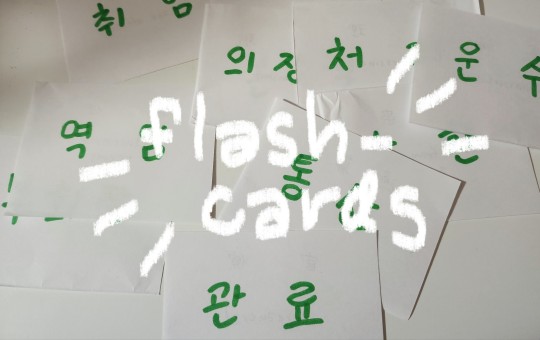
Yippee!
I've been using flashcards since elementary school and this is my favorite way of using them. I'll use Korean words to showcase my method.
Usually I'll have a main side and secondary side. I'll write the main side in large letters and use a fun color and the secondary one with black pen. Here I used green to contrast the black. Idk colors motivate me...
I'll have a few words from different categories every time.
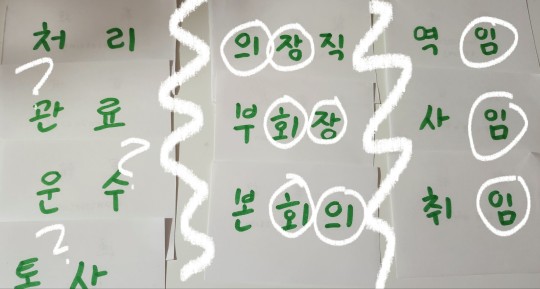
Here's what I mean: a few categories with similar-sounding words and one with random words. I never exclusively do similar-sounding words as I remember better when there are only a few similar ones.
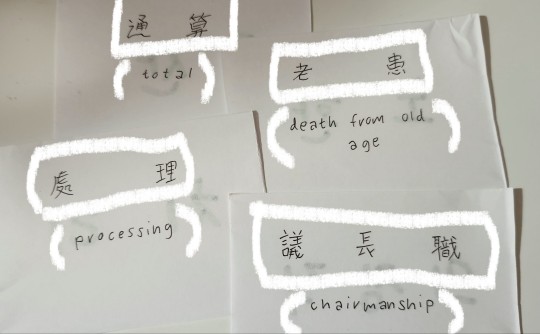
The secondary side has two definitions, usually either two writing systems or two languages (polyglot tingz) so I get as much out of these cards as I can. In this case, there's hanja and English!
I'll flip through a pack like this for a few days, usually 2-3. Then I'll make another one!
I'll take the pack out again in a month and if I don't remember a word, I'll add the word to my current pack! If old cards keep coming back, I'll stop making new ones and study the old ones until I remember.
#langblr#language#learning#korean#한국어#studyblr#flashcards#new words#words#learning tips#hanja#한자#한국어 공부
7 notes
·
View notes
Text
Tips for watching K-dramas raw
Today I thought I’d share how I worked my way up to watching K-dramas raw. It’s pretty simple:
🔑 The key is to start with watching Korean children’s cartoons.
It can be daunting to jump right into watching K-dramas without subtitles because there’s bound to be a lot of words you don’t understand and the characters often speak pretty fast. By starting with cartoons, you can reinforce your basic Korean vocabulary while building up confidence in your listening skills by getting used to actively listening to Korean dialogue. Also, cartoons are more bite-sized than K-dramas, so you can really work your listening skills without burning yourself out.
Recommendations: 브레드 이발소 (Bread Barbershop), 띠띠뽀 띠띠뽀 (Ttittipo Ttittipo)


➡️ Once you’re comfortable with cartoons, you can move on to your traditional K-dramas.
I recommend starting with rom-coms and office dramas as they include practical vocabulary you’d hear day-to-day. It’s also helpful to look for vocabulary sets relevant to the type of drama you’re watching. (So if you were watching an office drama, look for vocabulary sets pertaining to the workplace). Memorizing those words beforehand will really help you figure out what’s going on in the drama based on the context.
Recommendations: 이번 생도 잘 부탁해 (See You in My 19th Life), 아무것도 하고 싶지 않아 (Summer Strike)


🎓 Finally, once you’re used to rom-coms and office dramas, you can graduate to more advanced dramas like fantasy dramas or historical dramas.
In my opinion, these dramas are like the final boss of K-dramas because fantasy dramas can just have straight up made-up words and historical dramas use antiquated speech and frequently use metaphors that are hard to follow.
Recommendations: 육룡이 나르샤 (Six Flying Dragons), 장옥정, 사랑에 살다 (Jang Ok Jung)


I know this post was kind of long, but I hope it helps. (Plus I just wanted to talk about Korean cartoons 🤷🏾♀️)
Happy studying! 👋🏾
10 notes
·
View notes
Text
Finally, my intro!
About ; My name is Blanka, and I'm 16 years old! I'm generally unmotivated, but I have a goal in mind, which is to be an anthropologist, and to learn as many languages as I can! So I finally decided to open up a blog!
Languages ; Hungarian (native), English (C1), French (B1, used to be C2), Korean (A1)
Fav things? ; Kpop (NOT a koreaboo), Arcane (lol series), Jurassic park/world, history, poetry, true crime, COLD, Cold drinks.
#study notes#studyinspo#studystudystudy#studyspiration#student life#study inspiration#studygram#studywithme#study space#hungarian language#hungarian langblr#language learning tips#french langblr#korean langblr#Langblr#language learning#Studyblr
16 notes
·
View notes
Text
How to learn new foreign words 💡
7 steps - 7 days method to memorise new foreign words
Day 1
Write 25-30 words, but no random words. You can add pictures or combine these words with your native language words (ex. my 사랑 mother) ✍🏼
Day 2
Repeat these words and create flashcards. It is better to use Quizlet because it has a built-in translator and audio 🗃️
Day 3
Record audio how you pronounce words with intonation. Before recording, don’t be lazy to check all transcriptions or how native speakers pronounce them🗣️
Day 4
Go through your list of words again, put away paper and try to write as many words as you remember with translation 🧠
Day 5
Listen to your audio and while listening, write words (on day 3, when you record words, rearrange them). So this day you take dictation 👂🏼
Day 6
Flashcards 5-7 minutes or more (actually you can do them when you have a free minute during these days) ⏰
Day 7
In the morning, repeat words - say them out loud and write. While writing, try to combine with words you have already known. In the evening do it again 📚
Don’t forget to check these words with flashcards or audio from time to time adding new words 📆
#medicine inside#studyblr#study with me#study languages#study effectively#study english#how to learn new words#study tips#study hacks#study methods#study german#study korean#study session#studyspiration
97 notes
·
View notes
Text
Similar to my last post about Spanish or Portuguese , this is how to tell the difference between chinese and Japanese, because of just how similar they look! (Keep in mind I'm only studying Japanese and don't know ANY Chinese, so some of this may be off! SORRYYY!!!)
GENERAL HISTORY AND BACKGROUND:
One of the big things that makes Japanese and Chinese writing so similar is that Japanese takes many words from Chinese and puts them into in the Kanji writing system, which has over 50,000 separate characters, although the average native japanese speaker knows between 1500 and 2500. Along with hiragana, which is used for words in/from Japan. Then theres katakana which is used for foreign words, (like names and foods) and each writing system is used interchangeably and can be mixed up even in the same sentence! (Its REALLY confusing)
In Japanese too (but not for foreign words) each word can have 1 or 2 translations, either in hiragana or kanji. All Kanji does to a word is turns it into a more complicated, but more comprehensive version to make it more recognizable and faster to read. (SO CONFUSING)
For example, the word for cat in hiragana is ねこ, (pronounced Ne-ko) while in kanji it would be 猫 (also pronounced Ne-ko!). They're pronounced the exact same, but written differently.
a good example of this would be numbers! The translation to japanese would be either いち (hiragana) or 一 (kanji) both the hiragana and kanji pronunciation would be the same, which would be I-chi. In chinese, one would also be 一, but pronounced Yī this time! same writing, different pronunciations!
Although, not all Japanese words have Kanji set to them. So to fill in the gaps, they have to use the other writing systems like Katakana and Hiragana. Every sentence can be written multiple ways!
VISUAL DIFFERENCES AND.. NOT HISTORY:
So, lets say I wanted to translate "My brother Oliver is from the united states" into both Japanese and Chinese. In japanese, words like oliver and United states would be translated into katakana since they are foreign words. while in chinese they would find the closest character to match the sound.
In japanese, quotation marks are represented with 「 and 」 , while in chinese its still " and "!
Keep in mind that compared to kanji, katakana and hiragana are much simpler!
(im taking these translations from google so take the writing with a grain of salt!!)
so, in katakana, oliver = オリバー and united states = アメリカ . these translations basically sound out the words, so if you were saying it it would sound pretty close to english! (O-ri-ba, and a-me-ri-ka)
the direct translation to japanese would be 私の弟のオリバーはアメリカ出身です. pay attention to the complexity of each symbol and now look over at the chinese translation, which would be 我的兄弟奥利弗来自美国. the characters are MUCH more complicated! To make up for that, sentences in japanese are more likely to be longer length wise because of the breaking up of the words (but not always!)
So, lets try with a couple more examples! make sure to be looking at the characters and the complexity of each of them!
Sentence: I need to go to the convenience store
Japanese: コンビニに行かなければなりません
Chinese: 我要去便利店
Sentence: Which curtain should we get?
Japanese:どのカーテンを買おうか?
Chinese: 我们应该买哪种窗帘?
Sentence: Can I get another chip?
Japanese: 別のチップを入手できますか?
Chinese:我可以再买一个芯片吗?
Sentence: I was responsible for what happened to John F. Kennedy
Japanese: ジョン・F・ケネディに起こったことの責任は私にあった
Chinese: 我对约翰·F·肯尼迪的遭遇负有责任
Sentence: I like to play video games in my free time
Japanese: 私は自由時間にビデオゲームをするのが好きです
Chinese: 我喜欢在空闲时间玩电子游戏
Sentence: He asked me, "Can I pet that cat over there?"
Japanese: 彼は私に「あそこの猫を撫でてもいいですか?」と尋ねました。
Chinese: 他问我:“我可以摸摸那边的猫吗?”
Many things i have said in this could be wrong, so feel free to correct me! I just am tired of people mixing up these languages and these are some of the things that I have learned (other than knowing some japanese lmfao) have fun in whatever you choose to do with this!!
#japanese#chinese#languages#.. geoguessr tips#might make another version of this but with korean#and thai#once you get the hang of this it gets super easy#ANWAYS#hiro.txt#language
17 notes
·
View notes